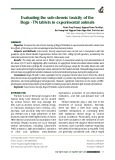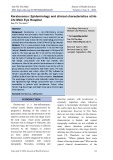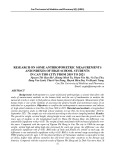
Can Tho Journal of Medicine and Pharmacy 10(7) (2024)
65
10. Jared Dart, Cindy Gallois, Peter Yellowlees. Community health information sources — a survey
in three disparate communities. Australian Health Review. 2008. 32(1), 186-196. DOI:
10.1071/ah080186.
11. Dang Duc Cuong, Hoang Thi Le, Le Thuy Lien. Nurses' health education at Ha Giang Hospital
in 2021. 2021, 17-26.
https://sti.vista.gov.vn/tw/Lists/TaiLieuKHCN/Attachments/335616/CVv476S372022017.pdf.
CLINICAL CHARACTERISTICS AND THE QUALITY OF LIFE OF
PATIENTS WITH GENITAL WARTS
Lac Thi Kim Ngan*, Hoang Thi Van Anh, Pham Thi Bao Tram,
Nguyen Thi Thuy Trang
Can Tho University of Medicine and Pharmacy
*Corresponding author: ltkngan@ctump.edu.vn
Received:20/03/2024
Reviewed: 09/05/2024
Accepted: 12/05/2024
ABSTRACT
Background: Genital warts are a disease with the highest proportion of sexually
transmitted diseases, which are caused by Human Papillomaviruses. Currently, research on the
impact on the quality of life of patients with genital warts in Vietnam is still very limited, while this
is an issue that deserves attention and has been studied in many places around the world. Objectives:
To describe the clinical characteristics and evaluate the quality of life of patients with genital warts
at Can Tho Dermato-Venereology Hospital in 2023. Materials and methods: A cross-sectional
descriptive study was conducted at Can Tho City Hospital of Dermato-Venereology, including 111
patients who were diagnosed with genital warts and treated. The generic questionnaire European
quality of life index version 5D (EQ-5D), and EQ visual analogue scale (EQ-VAS) have been used
to assess the quality of life of patients with genital warts. The period of study is from May 2023 to
October 2023. Results: Patients in the 14-35 age group accounted for the highest proportion
(81.1%), and the over 60-year-old group accounted for the lowest proportion (2.7%). The majority
of patients participating in the study were female (61.3%). Types of lesions included sharp papules
(78.4%), papular papules (12.6%), keratinized papules (6.3%), and flat papules (2.7%). The mild
and moderate disease severity were dominant (79.28%). Genital warts usually do not affect mobility,
self-care, or usual activities; however, this disease causes pain or discomfort (59.46%), and anxiety
or depression (62.16%). The average general health score according to the EQ-VAS, was 74.6 ±
9.031. There was a relationship between EQ-VAS and disease severity (p<0.002). The more severe
the disease was, the lower the average EQ-VAS score was. Conclusion: Genital warts had a
negative impact on many aspects of the patient's quality of life, including anxiety or depression,
varying from moderate to severe levels. Therefore, in addition to consulting and raising awareness,
paying attention to monitoring the problems above is extremely important in treatment.
Keywords: genital warts, quality of life, EQ-5D, EQ-VAS.
I. INTRODUCTION
Genital warts accounted for the highest proportion of sexually transmitted diseases
(STDs), caused by Human Papillomaviruses. Recent studies show that Human






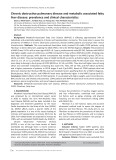


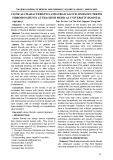
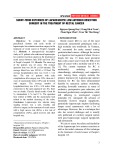
![Study on toxicities of 10β-[(2'β-hydroxy-3'- imidazol) propyl] deoxo-artemisinin (32) in reproductive and developmental progresses of mice](https://cdn.tailieu.vn/images/document/thumbnail/2025/20250228/viinuzuka/135x160/8021740737116.jpg)
